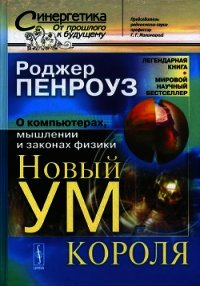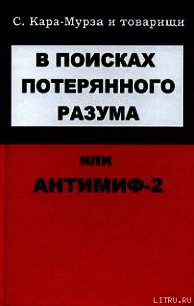Тени разума. В поисках науки о сознании - Пенроуз Роджер (книги без регистрации полные версии txt) 📗
108
Во введении в свою книгу [ 270] Мостовски ясно показывает, что аргументы, подобные гёделевским, не имеют никакого отношения к вопросу о возможности существования абсолютно неразрешимых математических задач. На настоящий момент вопрос следует считать полностью открытым — нет ни доказательства, ни опровержения. Как и в случае с двумя другими стрелками, нам остается лишь верить или не верить.
Литература
[1] Aharonov, Y., Albert, D. Z. (1981). Can we make sense out of the measurement process in relativistic quantum mechanics? Phys. Rev., D24, 359-370.
[2] Aharonov, Y., Vaidman, L. (1990). Properties of a quantum system during the time interval between two measurements. Phys. Rev., A41, 11.
[3] Aharonov, Y., Anandan, J., Vaidman, L. (1993). Meaning of the wave function. Phys. Rev., A47, 4616-4626.
[4] Aharonov, Y., Bergmann, P. G., Liebowitz, J. L. (1964). Time symmetry in the quantum process of measurement. В сб. Quantum theory and measurement (ed. J.A.Wheeler, W. H. Zurek). Princeton University Press, 1983; первоначально в Phys. Rev., B134, 1410-1416.
[5] Aharonov, Y, Albert, D.Z., Vaidman, L. (1986). Measurement process in relativistic quantum theory. Phys. Rev., D34, 1805-1813.
[6] Albert, D. Z. (1983). On quantum-mechanical automata. Phys. Lett., 98A (5, 6), 249-252.
[7] Albrecht-Buehler, G. (1981). Does the geometric design of centrioles imply their function? Cell Motility, 1, 237-245.
[8] Albrecht-Buehler, G. (1985). Is the cytoplasm intelligent too? Cell and Muscle Motility, 6, 1-21.
[9] Albrecht-Buehler, G. (1991). Surface extensions of 3T3 cells towards distant infrared light sources. J. Cell Biol., 114, 493-502.
[10] Anthony, M., Biggs, N. (1992). Computational learning theory, an introduction. Cambridge University Press.
[11] Applewhite, P. В. (1979). Learning in protozoa. В сб. Biochemistry and physiology of protozoa. Vol. 1 (ed. M. Levandowsky, S.H. Hunter), 341-355. Academic Press, New York.
[12] Arhem, P., Lindahl, B.I.B. (ed.) (1993). Neuroscience and the problem of consciousness: theoretical and empirical approaches. В сб. Theoretical medicine, 14, Number 2. Kluwer Academic Publishers.
[13] Aspect, A., Grangier, P. (1986). Experiments on Einstein-Podolsky-Rosen-type correlations with pairs of visible photons. В сб. Quantum concepts in space and time (ed. R. Penrose, C. J. Isham). Oxford University Press.
[14] Aspect, A., Grangier, P., Roger, G. (1982). Experimental realization of Einstein-Podolsky-Rosen-Bohm Gedanken-experiment: a new violation of Bell's inequalities. Phys. Rev. Lett., 48, 91-94.
[15] Baars, B.J. (1988). A cognitive theory of consciousness. Cambridge University Press.
[16] Bailey, T.N., Baston, R.J. (ed.) (1990). Twistors in mathematics and physics. London Mathematical Society Lecture Notes Series, 156. Cambridge University Press.
[17] Baylor, D. A., Lamb, T.D., Yau, K.-W. (1979). Responses of retinal rods to single photons. J. Physiol., 288, 613-634.
[18] Beck, F., Eccles, J. С (1992). Quantum aspects of consciousness and the role of consciousness. Proc. Nat. Acad. Sci., 89, 11357-11361.
[19] Becks, K.-H., Hemker, A. (1992). An artificial intelligence approach to data analysis. В сб. Proceedings of 1991 CERN School of Computing (ed. C. Verkerk). CERN, Switzerland.
[20] Bell, J. S. (1964). On the Einstein Podolsky Rosen paradox. Physics, 1, 195-200.
[21] Bell, J. S. (1966). On the problem of hidden variables in quantum theory. Revs. Mod. Phys., 38, 447-452.
[22] Bell, J. S. (1987). Speakable and unspeakable in quantum mechanics. Cambridge University Press.
[23] Bell, J. S. (1990). Against measurement. Physics World, 3, 33-40.
[24] Benacerraf, P. (1967). God, the Devil and Godel. The Monist, 51, 9-32.
[25] Benioff, P. (1982). Quantum mechanical Hamiltonian models of Turing Machines. J. Stat. Phys., 29, 515-546.
[26] Bennett, C.H., Brassard, G., Breidbart, S., Wiesner, S. (1983). Quantum cryptography, or unforgettable subway tokens. В сб. Advances in cryptography. Plenum, New York.
[27] Bernard, C. (1875). Lecons sur les anesthesiques et sur I'asphyxie. J. B. Bailliere, Paris.
[28] Blakemore, C., Greenfield, S. (ed.) (1987). Mind-waves: thoughts on intelligence, identity and consciousness. Blackwell, Oxford.
[29] Blum, L., Shub, M., Smale, S. (1989). On a theory of computation and complexity over the real numbers: NP completeness, recursive functions and universal machines. Bull. Amer. Math. Soc, 21, 1-46.
[30] Bock, G. R., Marsh, J. (1993). Experimental and theoretical studies of consciousness. Wiley.
[31] Boden, M. (1977). Artificial intelligence and natural man. The Harvester Press, Hassocks.
[32] Boden, M. A. (1990). The creative mind: myths and mechanisms. Wiedenfeld and Nicolson, London.
[33] Bohm, D. (1952). A suggested interpretation of the quantum theory in terms of "hidden'Variabies, I and II. В сб. Quantum theory and measurement (ed. J.A.Wheeler, W.H.Zurek). Princeton University Press 1983. Первоначально в Phys. Rev., 85. 166-193.
[34] Bohm, D., Hiley, B. (1994). The undivided universe. Routledge, London.
[35] Boole, G. (1854). An investigation of the laws of thought. 1958, Dover, New York.
[36] Boolos, G. (1990). On seeing the truth of the Godel sentence. Behavioural and Brain Sciences, 13 (4), 655.
[37] Bowie, G.L. (1982). Lucas' number is finally up. J. of Philosophical Logic, 11, 279-285.
[38] Brady, M. (1993). Computational vision. В сб. The simulation of human intelligence (ed. D. Broadbent). Blackwell, Oxford.
[39] Braginsky, V. B. (1977). The detection of gravitational waves and quantum non-disturbative measurements. В сб. Topics in theoretical and experimental gravitation physics (ed. V. de Sabbata, J. Weber), 105. Plenum, London.
[40] Broadbent, D. (1993). Comparison with human experiments. В сб. The simulation of human intelligence (ed. D. Broadbent). Blackwell, Oxford.
[41] Brown, H. R. (1993). Bell's other theorem and its connection with nonlocality. Part I. В сб. Bell's Theorem and the foundations of physics (ed. A. VanderMerwe, F. Selleri). World Scientific, Singapore.
[42] Butter-field, J. (1990). Lucas revived? An undefended flank. Behavioural and Brain Sciences, 13 (4), 658.
[43] Castagnoli, G., Rasetti, M., Vincenti, A. (1992). Steady, simultaneous quantum computation: a paradigm for the investigation of nondeterministic and non-recursive computation. Int. J. Mod. Phys. C, 3, 661-689.
[44] Caudill, M. (1992). In our own image. Building an artificial person. Oxford University Press.
[45] Chaitin, G. J- (1975). Randomness and mathematical proof. Scientific American (May 1975), 47.
[46] Chalmers, D.J. (1990). Computing the thinkable. Behavioural and Brain Sciences, 13(4), 658.
[47] Chandrasekhar, S. (1987). Truth and beauty. Aesthetics and motivations in science. The University of Chicago Press.
[48] Chang, C.-L., Lee, R.C.-T. (1987). Symbolic logic and mechanical theorem proving, 2nd edn (1st edn 1973). Academic Press, New York.
[49] Chou, S.-C. (1988). Mechanical geometry theorem proving. Ridel.
[50] Christian, J.J. (1994). On definite events in a generally covariant quantum world. Unpublished preprint.
[51] Church, A. (1936). An unsolvable problem of elementary number theory. Am. Jour, of Math., 58, 345-363.
[52] Church, A. (1941). The calculi of lambda-conversion. Annals of Mathematics Studies, No. 6. Princeton University Press.
[53] Churchland, P.M. (1984). Matter and consciousness. Bradford Books, MIT Press, Cambridge, Massachusetts.
[54] Clauser, J.F., Home, M.A. (1974). Experimental consequences of objective local theories. Phys. Rev., D10, 526-535.




